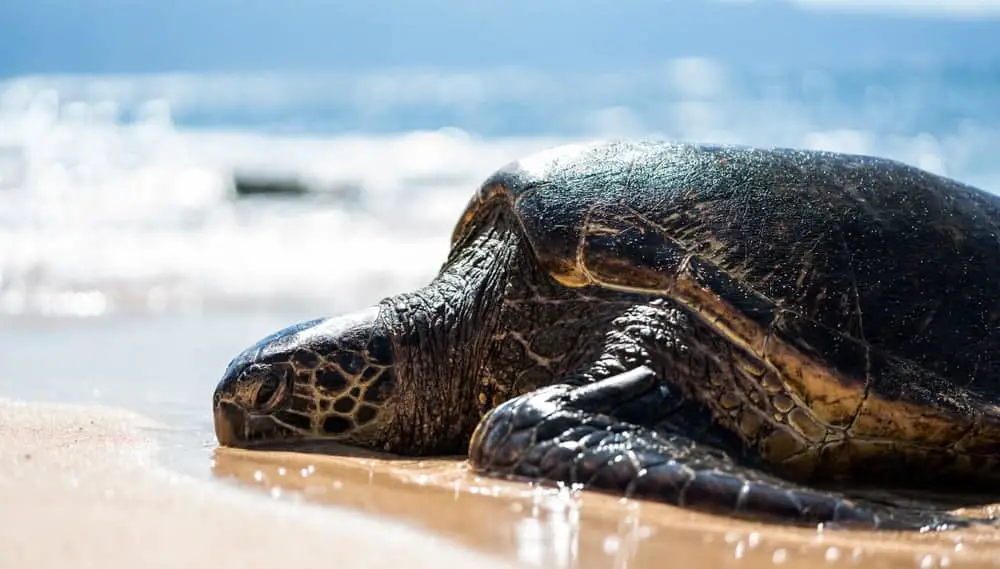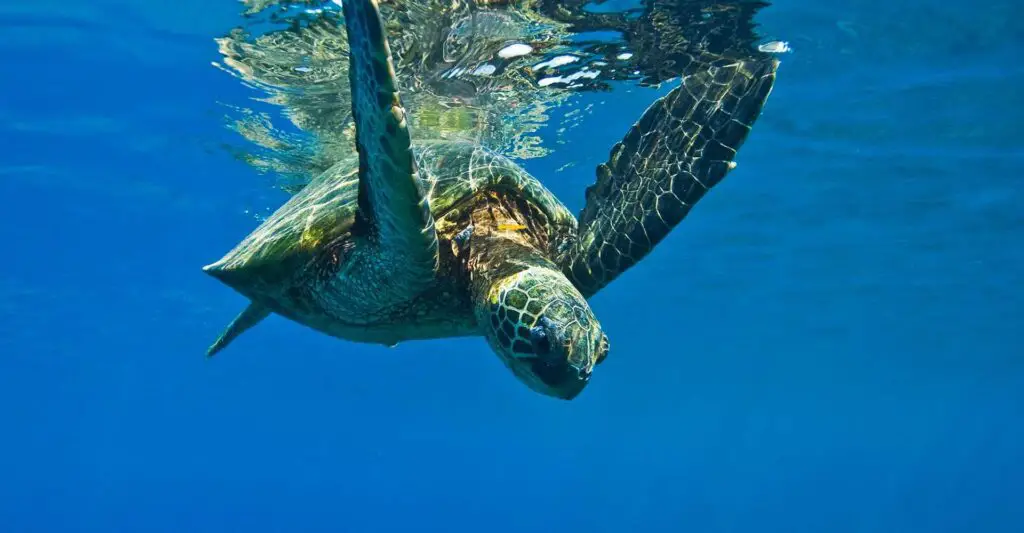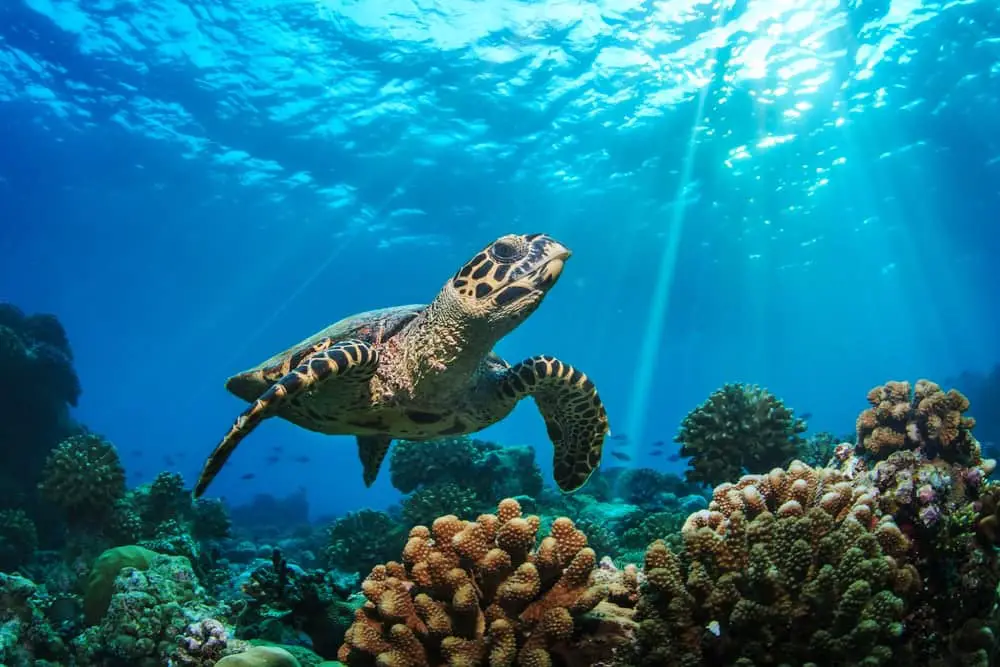Can Sea Turtles Go In Their Shells

Introduction
Can Sea Turtles Go In Their Shells: Sea turtles are among the most captivating and enigmatic creatures of the marine world. With their ancient lineage dating back over 100 million years, they have evolved into remarkable and resilient animals adapted to life in the oceans. One of the most commonly held beliefs about sea turtles is that, like their terrestrial relatives, they can retreat into their shells for protection. This perception has been ingrained in popular culture, perpetuated through cartoons, movies, and even scientific illustrations.
In this exploration, we delve into the fascinating world of sea turtles to uncover the truth behind this intriguing notion. We will dissect their anatomy, examine their evolutionary history, and unravel the mysteries of their behavior to determine whether sea turtles possess the ability to retreat into their shells as land turtles do.
The journey will take us through the diverse species of sea turtles, their habitats, and their remarkable adaptations to life in the ocean. We will also investigate the role of their shells and how they serve as vital tools for survival in a world filled with predators and environmental challenges.
Join us as we embark on this educational and eye-opening journey to separate fact from fiction, shedding light on the true nature of these magnificent creatures and their unique relationship with their shells.

Can turtles go inside their shells?
In fact, shells grow with the turtle. A turtle shell is made up of 50 bones in the turtle’s skeleton and includes the spine and rib cage. Almost all species of turtle can retract their heads and legs into the inside of their shell when they sense danger. But not all can.
Turtles are well-known for their unique protective shells, but the common perception that they can retreat entirely into them is not entirely accurate. Unlike some land turtles, such as box turtles, which possess hinged plastrons and can fully enclose themselves, most turtle species have shells that are fused to their skeletons, providing critical support and protection but limiting their ability to retract entirely.
When threatened or seeking shelter, turtles can withdraw their heads, limbs, and tail into their shells to varying degrees, depending on their anatomy and the species. This partial withdrawal allows them to shield their most vulnerable parts while maintaining a defensive posture. It’s important to note that turtle shells come in various shapes and sizes, reflecting the diversity of turtle species, and their shell structures have evolved to suit their specific ecological niches.
So, while turtles cannot completely disappear into their shells like a puzzle piece, they possess a clever defense mechanism that has served them well for millions of years. Their shells remain an iconic symbol of these ancient and resilient creatures in the animal kingdom.
Why can’t sea turtles hide in their shells?
Sea turtles have the same muscles as other turtles, which allows them to pull back their heads, but there is simply not enough space in the shell to fully retract the head. Sea turtles have a flatter shell than tortoises and have no space to retract their head into their shell.
Sea turtles, despite their remarkable adaptations for life in the ocean, cannot hide inside their shells for several crucial reasons. Unlike land turtles, such as tortoises, sea turtles’ shells are not designed for full retraction. There are several factors contributing to this inability to retreat entirely into their shells:
Shell Structure: Sea turtle shells are streamlined and adapted for aquatic life. They are composed of bony plates fused to the turtle’s spine, providing essential support and protection. This rigid structure lacks the flexibility and mobility required for complete retraction.
Swimming Adaptations: Sea turtles are powerful swimmers, and their streamlined bodies and limb adaptations are essential for navigating the open ocean. Fully retracting into their shells would hinder their mobility and swimming capabilities, making it impossible for them to catch prey, evade predators, or migrate over long distances.
Predatory Deterrence: Sea turtles rely on their size and strength as well as behaviors like flippers and sharp beaks to deter potential predators. Hiding in their shells would leave them vulnerable and unable to defend themselves effectively.
The structure and lifestyle of sea turtles have evolved to prioritize adaptation to the aquatic environment rather than full retraction into their shells. These remarkable creatures have developed alternative strategies to survive and thrive in the dynamic and challenging world of the ocean.
How long can a turtle stay in its shell?
A turtle can stay in its shell for as long as it needs to. The shell is a permanent part of a turtle’s body and provides protection, serving as a home and a safe retreat.
Turtles can stay partially inside their shells for extended periods, primarily for protection or to weather unfavorable conditions. However, the duration they spend in this partially retracted state can vary depending on the species and the specific circumstances.
Most turtle species, including land turtles like tortoises and semi-aquatic turtles, can retract their limbs, head, and tail into their shells as a defense mechanism when they feel threatened. This retreat serves to shield their most vulnerable parts from potential predators. How long they remain in this defensive posture often depends on the perceived level of threat. If the danger persists, they may stay hidden for an extended period, even hours or more.
However, it’s essential to understand that turtles cannot remain fully inside their shells indefinitely. Their shells are not designed for complete retraction like a box or terrapin. Instead, they maintain a level of exposure to the external environment, even when in their defensive posture.
While turtles can stay partially inside their shells for varying durations, there is a limit to how much they can retreat. The extent of their retraction and the time spent in this state depend on the individual turtle’s perception of danger and its specific behavioral adaptations.
Can a turtle live without a shell?
While a turtle’s shell is an essential part of its anatomy, it cannot survive without it. The shell provides protection, support, and helps with temperature regulation.
The turtle’s shell is an integral part of its anatomy, serving as both a protective structure and a vital component of its skeletal system. The shell is composed of two main parts: the upper carapace and the lower plastron, which are fused to the turtle’s spine and ribcage.
The shell provides essential protection for the turtle’s internal organs, including the heart, lungs, and digestive system. It acts as a shield against predators and environmental threats. Without this protective barrier, a turtle would be extremely vulnerable to injury and would struggle to survive in the wild.
The turtle’s shell is not just an external covering; it’s a living part of its body. It consists of bones and a layer of keratin, the same protein found in human hair and nails. The shell grows with the turtle as it matures, and it cannot be removed without causing severe harm or death to the turtle.
A turtle’s shell is indispensable for its survival, protection, and structural integrity, and a turtle cannot live without it.
Can a turtles shell hurt?
A: Yes a turtle’s shell does have feeling! If you scratch a turtle, he will feel it just as if you were scratching his skin. He can also feel pain through his shell. We’ve sadly seen many cases where humans have drilled holes in turtles’ shells.
A turtle’s shell, while sturdy and protective, can indeed become a source of discomfort or even harm under certain circumstances. The shell, composed of bone and covered with plates made of keratin, serves as a natural defense mechanism against predators. However, it’s not impervious to injury. When a turtle is subjected to excessive pressure or force, its shell can crack, leading to pain and vulnerability. Additionally, if the shell sustains damage, it may hinder the turtle’s ability to move and forage for food, potentially leading to further health issues.
If a turtle’s shell is not properly cared for, it can become susceptible to various infections or parasites. Improper living conditions, such as unclean water or inadequate basking areas, can contribute to shell problems. In such cases, the shell’s protective function may be compromised, making the turtle more susceptible to harm from both natural elements and potential threats in its environment.
It is crucial for those who care for turtles as pets or encounter them in the wild to be mindful of their well-being and to provide suitable habitats. Regular veterinary check-ups, a balanced diet, and a clean living environment are essential in ensuring a turtle’s shell remains a safeguard rather than a source of harm.
Do sea turtles use their shells for protection at all?
Sea turtles, unlike their terrestrial counterparts, have evolved in a way that their shells are streamlined and lightweight, making them well-suited for life in the ocean. While not as rigid or robust as those of land-dwelling turtles, sea turtle shells do offer a degree of protection. Their shells serve as a shield against some predators and environmental hazards.
In particular, sea turtle shells provide defense against smaller, less powerful predators like sharks and larger fish. The shell’s design allows sea turtles to navigate through the water with relative ease, reducing their vulnerability to swift and agile marine predators. It also acts as a barrier against abrasive elements such as rocks and coral, safeguarding the turtle’s soft tissues from injury while navigating through their habitats.
However, it’s important to note that a sea turtle’s primary defense strategy lies in its ability to navigate the vastness of the ocean, relying on its speed, agility, and camouflage to avoid potential threats. Unlike land turtles, sea turtles cannot retract into their shells for complete protection. Therefore, while their shells play a role, they are just one component of the sea turtle’s broader adaptive strategies for survival in their aquatic environment.
Are there any sea turtle species with slightly more protective shells?
Among sea turtle species, the Kemp’s ridley turtle (Lepidochelys kempii) possesses a relatively more protective shell compared to its counterparts. While still streamlined for efficient swimming, the Kemp’s ridley shell exhibits a slightly more rigid structure than other sea turtles. This adaptation is thought to be an evolutionary response to the turtle’s preference for coastal habitats, where encounters with potential predators are more likely.
The Kemp’s ridley turtle is characterized by its olive-gray carapace, which is heart-shaped and somewhat keeled. This keel, or ridge, running down the center of the shell, provides a degree of reinforcement and could potentially deter predators or offer additional protection in confrontations.
Despite this slight enhancement in shell structure, the Kemp’s ridley turtle, like all sea turtles, primarily relies on its speed, agility, and camouflaging abilities to evade predators. It’s worth noting that even with a relatively more protective shell, no sea turtle species has the ability to retract into its shell for complete safety, as some land turtles do.
Overall, while the Kemp’s ridley turtle’s shell offers a bit more defense, it’s just one facet of the many adaptations that sea turtles have developed for their survival in the dynamic and sometimes perilous marine environment.
Can sea turtles retract into their shells like land turtles do?
Unlike their land-dwelling counterparts, sea turtles cannot retract into their shells. This fundamental distinction arises from the distinct evolutionary paths taken by these two groups of turtles. Land turtles, also known as tortoises, have evolved the ability to retract into their shells as a primary defense mechanism against predators. Their shells are more robust, and they possess specialized hinges in their skeletal structure that allow them to withdraw their limbs and head fully.
Sea turtles, on the other hand, have evolved to be more streamlined for efficient swimming. Their shells are lighter and flatter, designed to reduce resistance in the water. This adaptation sacrifices the ability to retract, which would hinder their mobility in the ocean. Sea turtles have adapted to rely on their agility, speed, and, in some cases, camouflage as their primary means of defense against predators. They are well-suited for navigating the expansive ocean environment, but their shells provide less protection against potential threats compared to the shells of land turtles.
The inability to retract into their shells is a crucial distinction between sea turtles and their terrestrial counterparts, reflecting the different evolutionary pressures and habitats that have shaped these fascinating creatures.

Conclusion
Our exploration into the question of whether sea turtles can retreat into their shells has revealed a fascinating glimpse into the world of these ancient marine creatures. While the common perception that sea turtles can tuck themselves inside their shells, much like their terrestrial counterparts, may be rooted in folklore and popular culture, our investigation has shed light on the scientific reality.
Sea turtles, unlike land turtles, lack the ability to retract fully into their shells. Their shells are fused to their skeletons, providing essential support and protection but limiting their flexibility compared to terrestrial turtles. Instead, sea turtles have evolved a remarkable suite of adaptations for survival in their oceanic environments, including streamlined bodies, powerful limbs for swimming, and specialized behaviors to deter predators.
Understanding these unique features of sea turtles enhances our appreciation for their resilience and their importance in maintaining the balance of marine ecosystems. Their shells, rather than being escape mechanisms, serve as vital tools for protection against predators and the harsh conditions of the open ocean.
While sea turtles may not retreat into their shells in the same way land turtles do, they remain extraordinary creatures with a wealth of adaptations that have allowed them to thrive in the world’s oceans for millions of years. Their story is a testament to the wonders of evolution and the beauty of the natural world.



